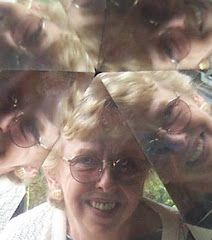Friday, June 05, 2009
Producing newsletters for business clients is one of the more pleasurable projects that I have done. Business owners love to have a professional looking format to get their message out to prospects plus they enjoy being able to educate their customers about their products or services. It doesn't matter if they're in a professional field, or they're in real estate, landscaping, wedding planning, decorating homes, selling floorcoverings, or a myriad of other businesses, a newsletter can both advertise to and educate their customers and prospects. Plus, the public doesn't mind receiving this kind of promotional material, unlike most junk mail that merely seeks to sell something.
As a freelance writer, this is something that can be profitable in any community. Even if yours is a rural community, if there are organic farmers or craftspeople seeking to sell at farmers' markets, a handout that advertises their products while offering nutritional information, recipes, or crafty ideas will garner more loyal customers. Think creatively about who in your neighborhood might profit from a newsletter produced by you.
First of all, write up a newsletter sample to use to approach your prospects. It can be about almost anything. Anyone can learn to use software to layout a newsletter, including embedding photos. If you haven't tried a desktop publishing program before, there's no better time than now. I'm sure you will enjoy this creative, professional format for your writing endeavors. Many of the programs cost very little - you don't need expensive software to create an attractive newsletter. In fact, even with Microsoft Word, you can produce a very professional looking newsletter.
I would advise checking out a book on newsletter production from your library. If the local one doesn't have this type of book, ask if they can do an intercity or statewide library search for you. This is exactly how I learned what professional-looking newsletters should look like. You can also go to local businesses and ask if they already send a newsletter to their prospects and request to be put on their mailing list, or ask for a copy. Collect enough, and you'll have an overview of both the good, bad and ugly in newsletters, and can decide how you want yours to look.
Your goal isn't to copy someone else's newsletter. Study enough of them, and you'll soon see how you can get creative without copying. Most newsletters have much in common, such as two- or three-column format with a large title on the top of the first page. You can also study the fonts used in articles to find the one that is the easiest to read, then use that same font for your own. Most newsletters are written in New Roman Times font, or possibly Helvetica or Arial. Experiment with font sizes until you find the size that is most comfortable to read. For instance, New Roman Times appears smaller than others in the same size, so a 12 point font is often much more readable, while a 10-point of 11-point Arial will usually suffice. Your font size may also depend on how many words you want to include in your articles and how much blank space you have to fill.
All articles in the same newsletter should use the same font and point size, while headlines will be larger. The largest font will be used for your Newsletter title, and can be either a decorative font or a plain one on a block of gray background, or on plain background.
Experiment on your computer until you have a design you like, then print up a dummy newsletter to approach prospective clients. If you don't have a computer, or you don't plan to use desktop publishing software, you can type of a simple, one column newsletter with the headlines in bold type and the rest in plain. Or you can hand-create a masthead (title page) with ink and hand lettering, or lettering created on either your typewriter or computer. If you hand draw a Title page, you can make copies and use the copies to type up the front page of each newsletter. The remaining pages, if any, don't need the title on them.
The very first newsletters I produced were for a church and a volunteer organization, and they were done on a typewriter with a hand drawn title page. But most businesses use computers and they expect any writer and newsletter publisher that they hire to be computer saavy enough to produce their newsletter on a computer. Some businesses will even allow you to use a company computer to produce a newsletter for them. In this case, quote a price that is a little lower than what you could expect for producing it on your own equipment.
I once knew a young woman hired to go into an office once a month to produce a newsletter for a salesperson, and was paid an hourly fee of about $15.00. As a writer and newsletter producer on my own, I would have charged about $250 for the project if the sales person was having it printed, plus printing costs if I had it printed for him. Since I had experience, I would have, of course, been able to produce it much quicker than this young woman. It took her 10-15 hours to do the same thing on the company computer, but the results were slower and not as professional as they could have been had she been working alone without the distractions of a busy workplace.
I would encourage any freelance writer to seek out clients for newsletters. Businesses love them, their customers love them, and you'll enjoy doing this type of work, especially once you've gotten some experience under your belt.
Everybody Loves Hot Air Balloo
A hot air balloon landing in the RV Park in Verde Valley is a fairly regular occurrence.
For starters, let me explain that I have never yet ridden in a hot air balloon. It’s not that it doesn’t look thrilling, or that I wouldn’t love the view from one. Instead, it’s my aversion to cold—and from experience I know it is mighty cold at daybreak, even here in Arizona in summer.
My first up-close experience with a balloon was when I was writing for a newspaper in Washington State and was assigned to interview an eighty-something year-old woman who owned a balloon business. She asked if I would like to watch the launching of one, so I agreed to meet her at some ungodly hour in a field somewhere to get photos and watch the takeoff at daybreak. I did get some great photos (property of the newspaper) from the inside of the balloon as it was being inflated.
Then the woman asked if I would like to “chase” the balloon to its landing spot. What she meant by “chasing” was following by road and trying to figure out where it would land as it dipped behind trees and hills. That’s when I learned that hot air balloons don’t have a specific landing area because it all depends on air currents. So we chased it for miles until it finally started drifting downward, but I couldn’t get close enough in the car to get photos, and I certainly wasn’t going to hike through muddy fields in that damp, frosty air!
Since then, I’ve witnessed several balloons lifting off and landing here in Arizona, and specifically, settling to the ground here in the RV Park outside Cottonwood. This morning was one of those occasions. About 6:30 AM I heard the familiar wh-o-o-o-sh, wh-o-o-o-sh of one overhead and looked out the window to see it coming down over the park, and then grabbed the camera.
Again, this is an instance where traveling by RV increases the chances of witnessing hot air balloons both aloft and landing because both activities often coexist in high-tourist areas with wide open spaces. RVers can find plenty of opportunities to hitch a ride in one, if they wish. I had only seen a precious few balloons aloft before we started RVing.
Above is one of the photos I snapped early this morning.

